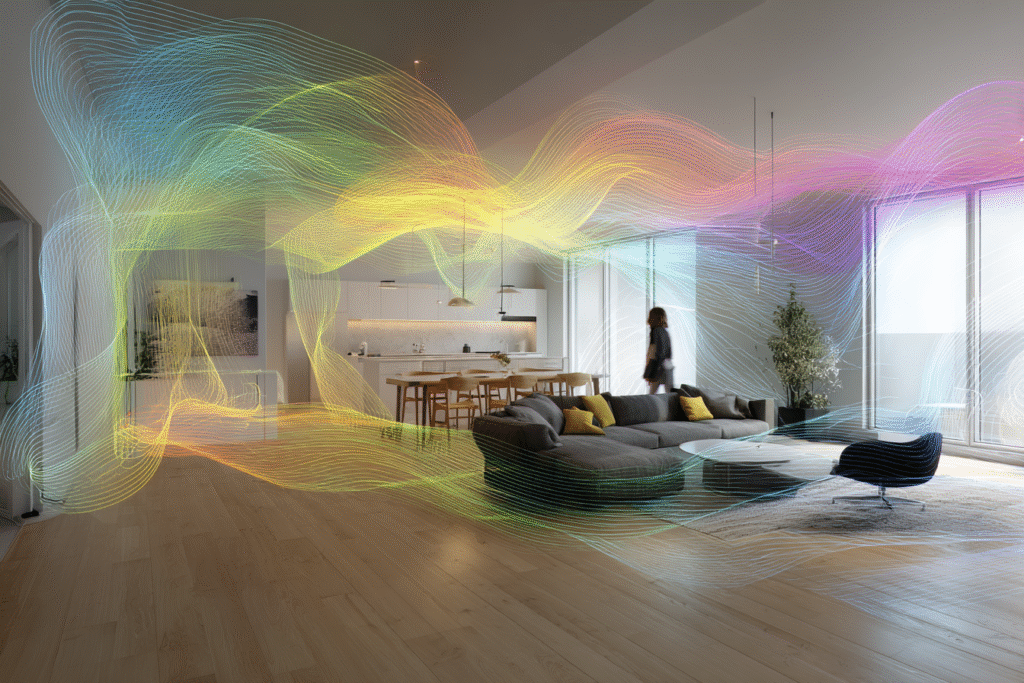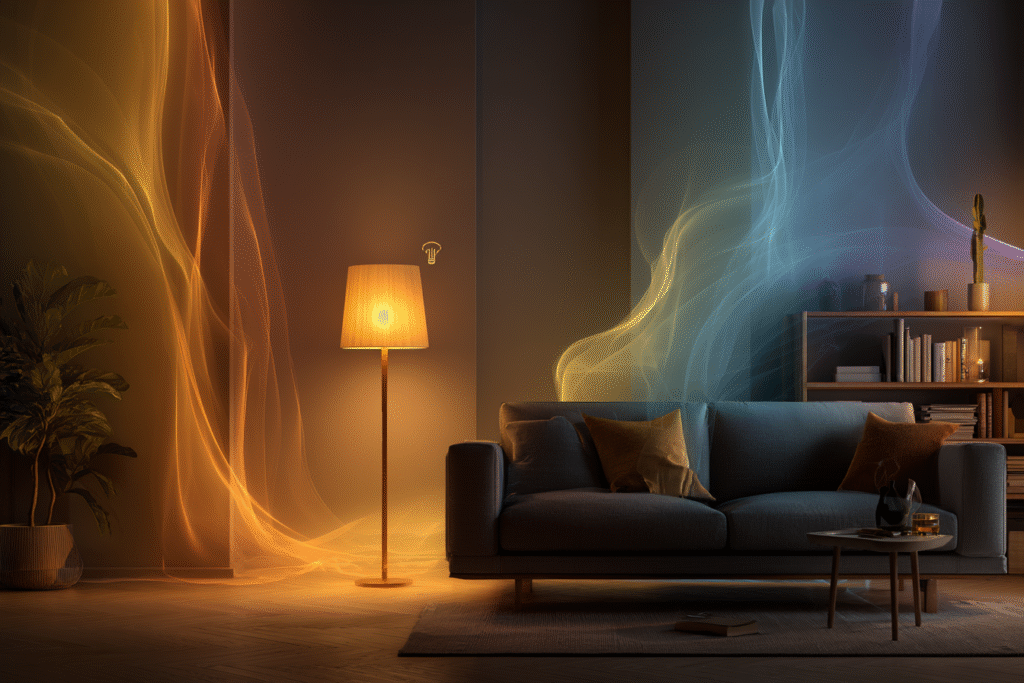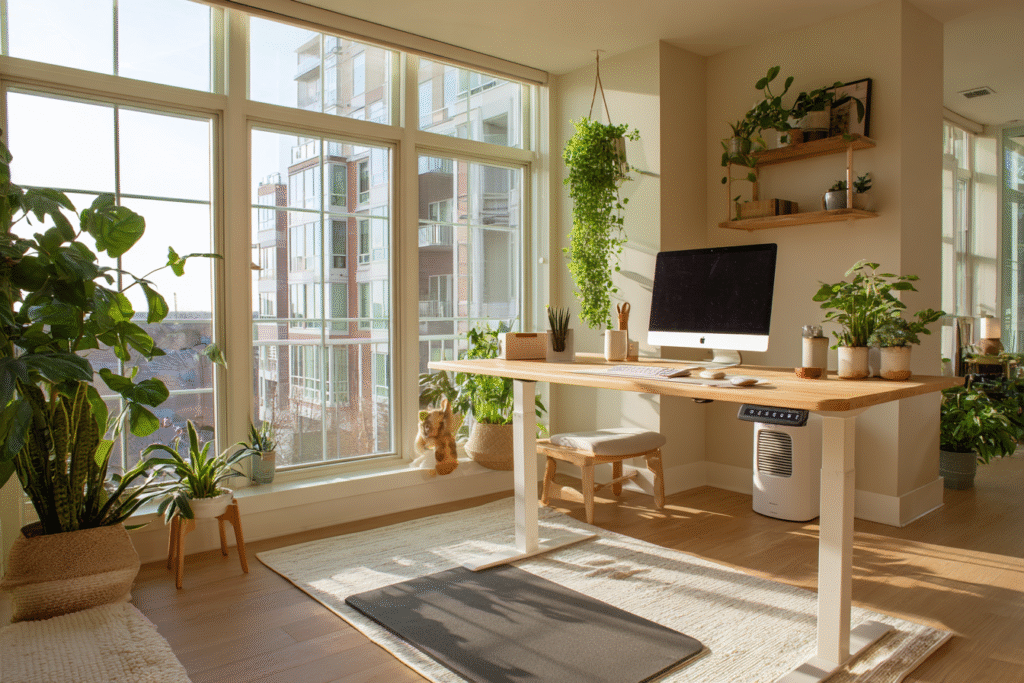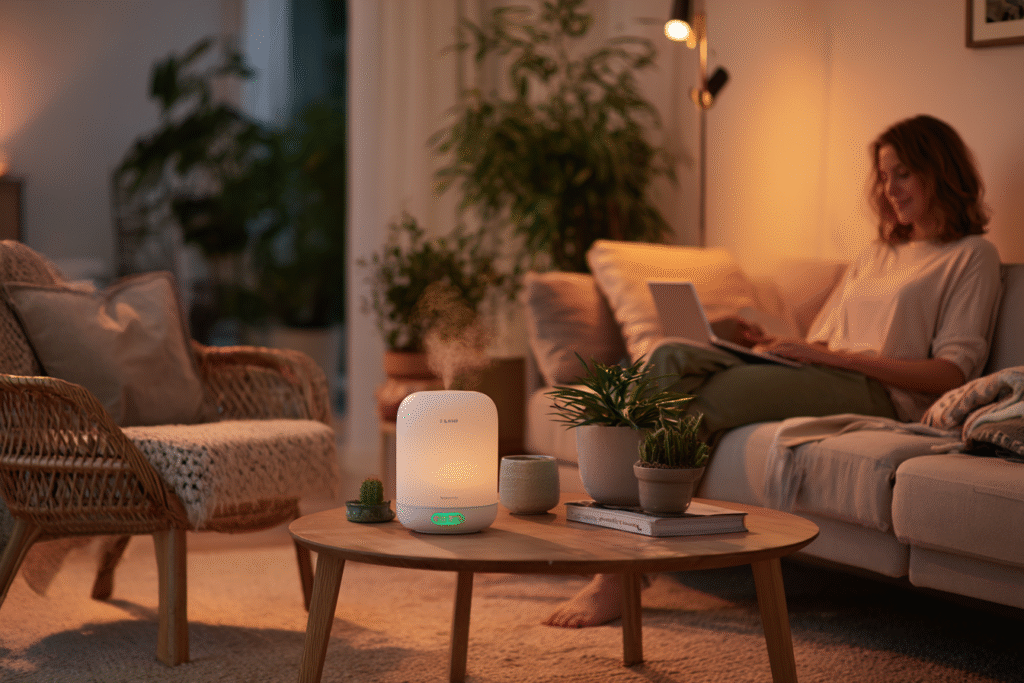We optimize everything—except the environment we spend 90% of our lives in.
Note: This article is for educational and informational purposes only. See full disclaimer at the end.
People track their steps and obsess over macros. But few have ever measured what they’re breathing, how their lighting affects their sleep, or whether their workspace is slowly sabotaging their health.
Throughout their lives, people will spend thousands of dollars on comprehensive health panels, tracking every biomarker from inflammation to hormone levels. Yet they never consider that their office lighting might be sabotaging their sleep, their home’s air could be triggering afternoon fatigue, or that their workspace is behind the neck pain plaguing them for months.
Like most of us, they optimize everything except the environment they spend 90% of their time in.
Your environment isn’t just background—it’s actively programming your biology.
The air you breathe, the light in your eyes, and the space around you are sending constant signals to your biology, influencing everything from your circadian rhythms to your stress hormones.
The revolutionary opportunity isn’t just creating healthier spaces—it’s creating intelligent spaces that actively support your wellbeing. Spaces that know when to adjust the lighting for better sleep, that monitor air quality in real-time, and that remind you to move before your body starts complaining.
Welcome to the world of smart health environments, where your space becomes your most powerful health partner.
Hidden Environmental Signals Shaping Your Health
Humans live in a 24-hour environment, in which light and darkness follow a diurnal pattern. Our circadian pacemaker, the suprachiasmatic nuclei (SCN) in the hypothalamus, is entrained to the 24-hour solar day via a pathway from the retina and synchronises our internal biological rhythms [1].

Yet most of us work under artificial lighting that confuses these ancient biological systems, breathe indoor air that’s often more polluted than outdoor air, and sit in positions that create chronic physical stress.
The data tells a stark story:
Air Quality Crisis: We spend 80% of our time indoors, and the indoor air is often polluted not only from sources outside your home but also from indoor pollutants like off-gassing furniture, cooking, and cleaning chemicals [2]. Poor indoor air quality contributes to respiratory issues, cognitive impairment, and chronic fatigue—yet most people have never measured what they’re breathing.
Lighting Disruption: Rather recently, the availability of artificial light has substantially changed the light environment, especially during evening and night hours. This may increase the risk of developing circadian rhythm sleep–wake disorders (CRSWD), which are often caused by a misalignment of endogenous circadian rhythms and external light–dark cycles [1].
Ergonomic Epidemic: Back pain is a common problem for many office workers, but few people realize that ergonomics can play a significant role in reducing or eliminating it. Poor posture and incorrect chair height can strain the spine, leading to tension headaches, chronic fatigue, and even long-term back problems [3].
The compound effect is devastating. Poor air quality impairs cognitive function. Disrupted lighting destroys sleep quality. Ergonomic stress creates chronic pain. Each factor amplifies the others, creating a cascade of health problems that we often attribute to aging, stress, or genetics—when the real culprit is our environment.
But here’s what changes everything: these environmental factors are completely within your control. And now, with smart technology, your environment can be more than just optimized—it can be intelligent.
Rethink Your Space as Health Tech
Think about your environment differently. Instead of passive space, imagine it as active health technology—systems that continuously monitor, adjust, and optimize to support your wellbeing.
This isn’t about expensive renovations or high-tech gadgets. It’s about understanding that every element of your environment is either supporting or undermining your health, and learning to create spaces that actively work in your favor.

Air Quality as Foundation
Your lungs are designed for clean, oxygen-rich air—but modern life rarely delivers that. Invisible pollutants are everywhere—from off-gassing furniture and harsh cleaners to stale, unventilated air.
Light as Biological Programming
Light exposure influences human health and wellbeing by modulating circadian rhythms and sleep [4]. The quality, timing, and intensity of light in your environment is literally programming your biology, affecting everything from sleep quality to mood regulation.
Space Design as Wellness Intervention
The goal of ergonomic workplace design is to intentionally choose the fixtures, layout and features of a workspace to increase worker efficiency and productivity while reducing discomfort [5]. But this extends far beyond office ergonomics—every space can be designed to promote rather than hinder health.
The smart integration opportunity lies in connecting these elements into a coherent system that responds to your needs, learns your patterns, and proactively supports your health throughout the day.
The Air You Breathe Rewires Your Brain
Air quality might be the most underestimated health factor in modern life. Unlike nutrition or exercise, air quality is invisible—yet its impact on your energy, cognitive function, and long-term health is profound.
The Hidden Air Quality Crisis
Indoor Air Quality (IAQ) refers to the cleanliness and safety of the air in a given space, which is affected by particles, gases, and humidity levels. Poor IAQ can result in health problems such as respiratory issues, allergies, and fatigue [6].
The specific pollutants in your environment tell a story:
- Particulate Matter (PM2.5): Fine particulate matter (PM2.5) reaches deep in the lungs causing short-term discomfort and long-term health risks [7].
- Volatile Organic Compounds (VOCs): Volatile organic compounds (VOCs) are airborne chemicals emitted by everyday items – many are harmless but some are toxic [7].
- Carbon Dioxide: When it reaches high levels indoors, carbon dioxide (CO2) can cause poor sleep and trouble concentrating [7].

Smart Air Quality Monitoring
The revolution in air quality management starts with measurement. Smart air quality monitors provide real-time information that will continuously keep you updated on your home’s air quality. These devices are designed to detect and measure pollutants, humidity, and temperature levels, alerting you to all unhealthy changes [6].
Modern smart monitors can detect multiple air quality parameters simultaneously, from PM2.5 and VOCs to humidity and temperature. The Amazon Smart Air Quality Monitor, for example, provides real-time feedback through Alexa integration, while more comprehensive systems like the Airthings View Plus monitor seven different air quality factors including radon [8].
AI-Driven Air Optimization
AI technology in smart homes has advanced significantly, allowing systems to anticipate and respond to air quality needs without requiring your input. Numerous smart home systems employ AI to identify patterns in air quality data. For example, if pollutants consistently rise in the evening, the system can automatically adjust the air purifier or HVAC settings immediately [6].
This predictive capability transforms air quality from reactive to proactive. Instead of waiting for problems to occur, intelligent systems learn your patterns and environmental conditions to maintain optimal air quality automatically.
Practical Implementation Strategy
Start with measurement. A basic air quality monitor costs less than a month of premium coffee, yet provides insights that can dramatically improve your daily energy and long-term health.
Choose monitors that track the most impactful factors: PM2.5 for particulate matter, CO2 for ventilation needs, and VOCs for chemical pollutants. Place monitors in the spaces where you spend the most time—bedroom, office, and main living areas.
Once you understand your air quality patterns, implement targeted solutions. High CO2 indicates poor ventilation—open windows or improve HVAC. High VOCs suggest chemical sources—identify and reduce sources like cleaning products or new furniture. High particulate matter calls for filtration—air purifiers with HEPA filters for your most-used spaces.
Light Is Medicine — Use It Like One
Light is perhaps the most underappreciated health technology we have access to. Every photon hitting your eyes is sending signals to your brain about what time it is, affecting hormone production, sleep quality, mood regulation, and cognitive performance.

The Circadian Revolution
Circadian rhythms are driven by internal biological clocks that operate on a 24-hour, day/night schedule meant to optimize our physiology. The intent of circadian lighting design is to work in harmony with our internal clocks by providing ample access to daylight or, when daylight is unavailable, modulating the intensity, spectrum, and color of electric light in symbiosis with the natural lighting cycle [9].
The challenge? We’ve disconnected from natural light. Office lighting often delivers a fraction of the brightness our biology expects, ~500 lx, often lower [1]. And blue-rich evening light? It delays sleep, disrupts hormones, and misaligns our internal clocks.
Smart Lighting Systems
A circadian lighting system requires a spectrum of color temperature and intensity that follows a specific light curve, adapting the quality of light based on the time of day, as well as the local conditions [9].
Modern smart lighting systems can automatically adjust throughout the day:
- Morning: Cool, bright light to promote alertness and cortisol production
- Daytime: Full-spectrum light to maintain energy and focus
- Evening: Gradually warming light to prepare for sleep
- Night: Minimal, warm light to avoid circadian disruption
The Implementation Reality
The variable-color-temperature lighting and ambient light quality throughout the offices far exceeds what industry standards like WELL qualify as circadian lighting. Even though we achieved WELL Gold certification for the Boston office, our designers always try to go beyond checking a box [9].
You don’t need a complete lighting overhaul to see benefits. Start with the spaces where you spend the most time. Smart bulbs with tunable white light can be programmed to follow circadian patterns automatically. For work areas, ensure access to bright light during the day—ideally near windows, or supplement with light therapy devices.
Light Exposure Behaviors That Matter
Light exposure patterns are crucial for optimizing cognitive function, productivity, and sleep quality [10]. People can control their light exposure through different behaviors by actively seeking or avoiding certain types of light exposure [10].
Simple behavioral changes can dramatically improve your light environment:
- Maximize morning light exposure to set your circadian clock
- Use bright light during focused work periods
- Reduce blue light exposure in the hours before sleep
- Create distinct lighting environments for different activities
While light programs your biology from the inside out, your physical environment shapes your health from the outside in.
The chair you sit in, the height of your desk, even how you position your body throughout the day—all of these send constant signals to your nervous system about whether you’re safe, supported, or under stress.

Your Body Is Talking to Your Furniture
Your physical environment is constantly influencing your body’s position, movement patterns, and stress levels. Poor ergonomics doesn’t just cause discomfort—it creates chronic physical stress that affects everything from energy levels to immune function.
The Ergonomic Health Connection
You may be able to avoid some of the health problems associated with seated work, such as neck and back pain and sore wrists and shoulders, by using proper office ergonomics. Chair height, equipment spacing and desk posture all make a difference [3].
But ergonomics extends beyond the office. Every space in your environment—kitchen counters, bedside tables, living room seating—either supports or stresses your body’s natural alignment and movement patterns.
Smart Ergonomic Solutions
Ergonomic solutions may include adjustable chairs, standing desks, and ergonomic keyboards. These tools help employees work comfortably and efficiently [5]. Modern smart ergonomic tools go further:
- Sit-stand desks with memory presets that automatically adjust to your preferred heights
- Posture monitoring devices that provide gentle reminders to adjust position
- Smart chairs that track sitting patterns and suggest movement breaks
- Environmental reminders through smart home systems to take regular breaks
Movement Integration
Remember, no matter how well your workspace is set up for proper ergonomics, sitting in the same position for hours at a time isn’t good for your body. Get up and walk around as often as you can throughout the workday [3].
Motivation fades. Design endures.
Place key items just far enough apart to encourage walking without friction. Alternate standing and seated work areas. Use reminders that gently nudge, not nag.
Let movement become built into the flow of your space.
Beyond Furniture: Environmental Ergonomics
Wellness-oriented office design focuses on creating a workspace that actively contributes to the well-being of employees. This involves more than just comfortable office furniture; it includes aspects of environmental psychology, ergonomics, and even elements of biophilic design [11].
Consider the psychological and physiological impact of:
- Color and visual environment: Calming colors for rest areas, energizing colors for work spaces
- Natural elements: Plants, natural materials, and views of nature
- Acoustic design: Noise control and sound masking for concentration
- Temperature and humidity control: Maintaining optimal comfort zones
Building a Smarter Environment, Step by Step
Creating a smart health environment doesn’t require a massive investment or complete overhaul. The key is understanding which changes will have the greatest impact on your specific situation and implementing improvements systematically.

Start with honest evaluation of your current environment:
Air Quality Assessment:
- Notice when you feel tired or have headaches indoors
- Check for obvious sources: new furniture, cleaning products, poor ventilation
- Consider a basic air quality monitor for objective measurement
Light Environment Assessment:
- Track your natural light exposure throughout the day
- Notice how artificial lighting affects your energy and sleep
- Evaluate your evening light exposure from screens and overhead lighting
Physical Environment Assessment:
- Document any physical discomfort during and after work
- Evaluate your workstation setup against ergonomic guidelines
- Consider how your space layout affects movement and posture
Priority-Based Optimization
Based on your assessment, prioritize improvements with the highest health impact:
High Impact, Low Cost:
- Improve air circulation and reduce VOC sources
- Maximize natural light exposure during the day
- Basic ergonomic adjustments to existing furniture
- Establish movement reminders and break patterns
Medium Impact, Medium Cost:
- Air quality monitoring and targeted purification
- Smart lighting with circadian rhythm support
- Ergonomic furniture upgrades for primary work areas
- Plants and natural elements for psychological benefit
High Impact, Higher Investment:
- Comprehensive air quality systems with smart controls
- Whole-home circadian lighting systems
- Advanced ergonomic furniture with smart features
- Environmental sensors with automated responses
Technology Integration Strategy
The goal isn’t maximum technology—it’s optimal technology that enhances health without creating complexity.
Start with monitoring to understand your environment objectively. Basic air quality and light meters provide crucial data for optimization decisions.
Then implement smart controls for the factors that have the greatest impact on your daily experience. Programmable lighting systems and automated air purification can provide significant benefits with minimal ongoing effort.
Finally, consider predictive systems that learn your patterns and automatically adjust environmental conditions. This level of integration transforms your environment from reactive to proactive health support.
When Your Environment Thinks With You
The true power of smart health environments emerges when individual systems work together intelligently, creating an environment that learns, adapts, and optimizes based on your unique patterns and needs.

Connected Environmental Intelligence
Modern smart home platforms can integrate air quality, lighting, climate, and wellness data to create sophisticated environmental responses:
- Circadian optimization: Lighting systems that automatically adjust based on your sleep schedule and local sunset/sunrise times
- Air quality automation: Ventilation and purification systems that respond to pollution levels and occupancy patterns
- Ergonomic reminders: Movement and posture prompts based on activity monitoring and schedule patterns
- Sleep optimization: Coordinated environmental adjustments for temperature, air quality, and lighting to improve sleep quality
Predictive Health Support
Proactive Air Quality Scenarios – For instance, if a smart monitor detects increased VOC levels while you’re cooking, it can automatically activate a connected air purifier or enhance ventilation [6].
This predictive capability extends beyond air quality:
- Seasonal adjustments: Automatically adapting lighting patterns as daylight hours change
- Weather-based optimization: Adjusting indoor conditions based on outdoor air quality and weather patterns
- Schedule integration: Preparing your environment based on calendar events and daily routines
- Health correlation: Learning which environmental factors most impact your energy, mood, and performance
Privacy and Control Considerations
Smart health environments require careful consideration of data privacy and personal control:
- Local processing: Choose systems that process data locally rather than sending all information to cloud servers
- Transparent controls: Ensure you understand and can control what data is collected and how it’s used
- Manual overrides: Maintain the ability to manually control all environmental systems
- Gradual implementation: Start with basic systems and add complexity only as you see clear benefits
Integration with Existing Health Data
Your smart environment becomes exponentially more effective when connected to your broader health data:
- Sleep tracking to optimize bedroom environment
- Activity monitoring to suggest movement breaks and posture changes
- Stress indicators to trigger calming environmental adjustments
- Cognitive performance patterns to optimize lighting and air quality during focused work
The goal is creating an environment that becomes an extension of your health optimization efforts—supporting the habits and practices that make you feel your best while minimizing the factors that drain your energy and wellbeing.

When Your Environment Becomes a Member of Your Health Team
As we’ve seen throughout our Health Transformation Arc, the most powerful approach to health isn’t about finding the perfect solution—it’s about creating systems that work intelligently together to support your wellbeing consistently over time.
Your environment is perhaps the most underutilized member of your health team. Unlike supplements you have to remember to take or exercises you have to motivate yourself to do, environmental improvements work automatically, supporting your health 24/7 without requiring ongoing effort or decision-making.
Building on What We Know
This environmental approach builds naturally on the frameworks we’ve established:
The AI Partnership Protocol from Day 50 applies perfectly to environmental systems—you remain the senior partner, using AI to enhance rather than replace your environmental awareness and control.
The Health Data Sovereignty principles from Day 53 are crucial for smart environment implementation—maintaining control over your environmental data and ensuring systems serve your interests rather than vendor interests.
The device-free health tracking approaches from Day 52 complement smart environmental monitoring—your body’s signals combined with objective environmental data provide the complete picture for optimization.
The Compound Benefits
Environmental improvements create compound benefits that amplify other health efforts:
- Better sleep from optimized lighting and air quality enhances everything from immune function to cognitive performance
- Reduced physical stress from ergonomic improvements increases energy available for exercise and other health practices
- Improved air quality enhances respiratory health and cognitive function, making other health decisions easier
- Automatic environmental optimization reduces the mental load of health management, freeing cognitive resources for other priorities
Your Implementation Path Forward
Start where you’ll see the biggest impact with the least complexity. For most people, this means:
- Air quality monitoring and basic improvements (remove VOC sources, improve ventilation)
- Circadian lighting optimization (maximize day light, minimize evening blue light)
- Basic ergonomic improvements (adjust existing furniture, add movement reminders)
- Gradual smart integration (automated controls for the most impactful factors)
Remember that environmental health is highly individual. What works in your specific space, with your unique schedule and health priorities, may be different from generic recommendations.
Use monitoring and self-experimentation to uncover what makes the most noticeable difference in how you feel and function.

One Space at a Time
The goal isn’t perfect environmental control—it’s creating an environment that consistently supports rather than undermines your health, becoming a reliable foundation for all your other wellness efforts.
Your space shapes your health more than you realize. With smart environmental design, you can ensure it’s shaping your health in the direction you want to go.
Your environment is more than walls and windows. It’s your interface with life. Make sure it’s speaking the language of your health.
See you in the next insight.
Comprehensive Medical Disclaimer: The insights, frameworks, and recommendations shared in this article are for educational and informational purposes only. They represent a synthesis of research, technology applications, and personal optimization strategies, not medical advice. Individual health needs vary significantly, and what works for one person may not be appropriate for another. Always consult with qualified healthcare professionals before making any significant changes to your lifestyle, nutrition, exercise routine, supplement regimen, or medical treatments. This content does not replace professional medical diagnosis, treatment, or care. If you have specific health concerns or conditions, seek guidance from licensed healthcare practitioners familiar with your individual circumstances.
References
- Zeitzer, J. M., et al. (2022). Recommendations for daytime, evening, and nighttime indoor light exposure to best support physiology, sleep, and wakefulness in healthy adults. PLOS Biology. https://journals.plos.org/plosbiology/article?id=10.1371/journal.pbio.3001571
- AirGradient (2025). Indoor Air Quality Monitor – Open-source/open-hardware low cost indoor air quality monitoring. https://www.airgradient.com/indoor/
- Mayo Clinic Staff (2023). Office ergonomics: Your how-to guide. Mayo Clinic. https://www.mayoclinic.org/healthy-lifestyle/adult-health/in-depth/office-ergonomics/art-20046169
- Li, J., et al. (2023). Light exposure behaviors predict mood, memory and sleep quality. Scientific Reports. https://www.nature.com/articles/s41598-023-39636-y
- Medcor (2024). Ergonomic Workplace Design and Your Business. https://medcor.com/occupational-health/ergonomic-workplace-design/
- uHoo (2024). Elevate Your Smart Home through Indoor Air Quality Monitor. https://getuhoo.com/blog/home/elevate-your-smart-home-through-indoor-air-quality-monitor/
- Airthings (2025). View Plus – smart indoor air quality monitor. https://www.airthings.com/en/view-plus
- Consumer Reports (2025). Best Indoor Air Quality Monitors of 2025. https://www.consumerreports.org/home-garden/indoor-air-quality-monitors/best-indoor-air-quality-monitors-of-the-year-a7500139084/
- Stacy, B. (2021). Light and wellness: A circadian approach to lighting design. Arup Insights. https://www.arup.com/insights/light-and-wellness-a-circadian-approach-to-lighting-design/
- Journeyman HQ (2025). 11 Smart Home Air Quality Monitoring Solutions That Experts Swear By. https://www.journeymanhq.com/21537/exploring-smart-home-technology-for-air-quality-monitoring/
- Corporate Wellness Magazine (2024). How to Create a Wellness-Oriented Office Space Design. https://www.corporatewellnessmagazine.com/article/how-to-create-a-wellness-oriented-office-space-design


